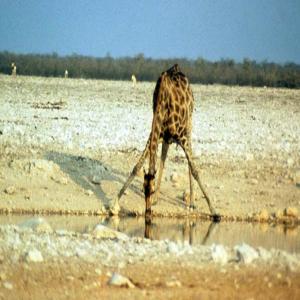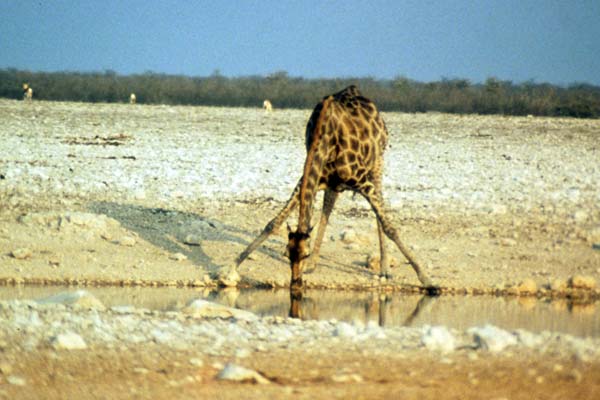Episodes

Saturday Jan 31, 2015
The WildLife: From bats to humans - echolocation for the blind, Carol Foster
Saturday Jan 31, 2015
Saturday Jan 31, 2015
While researching bats for one of her films, documentary filmmaker Carol Foster learned that humans were also doing what bats could do, namely using echolocation to see.That set her off on a project to help the blind in Belize learn this amazing skill. She’s even launched a crowdfunding campaign on Indiegogo to fund the effort. In this interview, we talk about what we can learn from bats and how the blind uses flash sonar to see the world.

Monday Sep 19, 2011
The WildLife: Wildlife documentaries, Carol Foster
Monday Sep 19, 2011
Monday Sep 19, 2011
Wildlife filmmaker Carol Foster reveals her secrets for filming wildlife in a manner that captures natural actions in a manner that does not disturb the animals. She tells "The WildLife" host Laurel Neme, about the special jungle studio that she and her filmmaker husband, Richard Foster, have constructed in the Belize which allows them to film wild behavior that would not otherwise be possible. For instance, they've captured on film a baby cantil viper wriggling the green tip of its tail over its head to attract and capture frogs. They've also filmed flower mites hitchhiking on the nostrils of a hummingbird. This episode of "The WildLife" originally aired on The Radiator, WOMM-LP, 105.9 FM in Burlington, Vermont on April 18, 2011. It was reposted on September 19, 2011.

Monday Jun 27, 2011
The WildLife: Howler Monkeys, Robin Brockett
Monday Jun 27, 2011
Monday Jun 27, 2011
Robin Brockett, former director of the Wildlife Care Center in Belize, talks about howler monkeys in Belize. She tells “The WildLife” host Laurel Neme how her research into their diet and habits has helped her with rehabilitate howler monkeys captured as pets for release back into the wild.
Howler monkeys are the loudest land animal in the world. They’re known for their loud, guttural, barking howls, which can be heard over three miles away. But did you know that they smell like steeped black tea? Or that they are picky eaters? While howler monkeys in Belize will eat 75 different species of leaves, they’re very particular about the age of the leaves. There are only a few types of leaves they’ll eat year-round. For example, (ficus) fig leaves appear the same all year long but sometimes the howlers will avoid it. That’s because these leaves have a high latex content, and at some point it becomes less palatable and less digestible.
Robin Brockett spent 16 years in Belize first researching howler monkeys in the wild and then spearheading the rehabilitation of confiscated pets back into the wild. Her work led to establishment of the Wildlife Care Center of Belize in 1999, where she served as director for over a decade. Over that time, Robin has nursed and released over 30 howler monkeys back into the wild. Before moving to Belize, Robin Brockett was a primate keeper at Zoo Atlanta for three years where she became involved in behavioral research. Prior to that, Robin spent three years at the Bronx Zoo in both the bird and mammal departments and also time in zookeeper positions at the Franklin Park Children's Zoo and the New England Science Center. She’s currently Assistant Bird Curator with the Audubon Zoo in New Orleans. She still works with the Belize government on issues related to the pet trade. This episode of “The WildLife” aired on The Radiator, WOMM-LP, 105.9 FM in Burlington, Vermont on June 27, 2011.

Monday Apr 18, 2011
The WildLife: Filmmaking from Jungle Studio in Belize, Carol Foster
Monday Apr 18, 2011
Monday Apr 18, 2011
Carol Foster talks about wildlife filmmaking. She tells “The WildLife” host Laurel Neme, how she and her filmmaker husband, Richard Foster, have constructed a special studio in the jungle of Belize that allows them to film wild behavior that would not otherwise be possible. For instance, they’ve captured a baby cantil viper wriggling the green tip of its tail over its head to attract and capture frogs, and also filmed flower mites hitchhiking in the nostrils of a hummingbird.
Carol and Richard Foster are documentary filmmakers specializing in natural history and the environment. Working out of their jungle studio, they have made films for the major networks including National Geographic and BBC. Both Carol and Richard are highly experienced at bringing to the screen the intricate hidden stories of natural behavior. Both have worked all over the world winning multiple awards for their work. They are currently using their skills to highlight the threats to the environment and nature by humans and climate change--subjects to which they are passionately committed. This episode of “The WildLife” aired on The Radiator, WOMM-LP, 105.9 FM in Burlington, Vermont on April 18, 2011.

Monday Dec 20, 2010
The WildLife: Tapirs & Saving Scarlet Macaws, Sharon Matola, Part 2
Monday Dec 20, 2010
Monday Dec 20, 2010
Sharon Matola, founder and director of the Belize Zoo, discusses her work with tapirs and her fight to save Belize’s last scarlet macaws. She tells “The WildLife” host Laurel Neme how her fight to stop the Challilo hydroelectric dam on Belize’s Macal River, which threatened numerous rare species, including the country’s last scarlet macaws, resulted in the government branding her an enemy of the state. This fight was documented in the book “The Last Flight of the Scarlet Macaw: One Woman’s Fight to Save the World’s Most Beautiful Bird” by Bruce Barcott. We also talk about tapirs and learn how one very special one, Tambo, is poised to become a true animal ambassador. This is the second of a two-part interview. Part 1 addresses what makes the Belize Zoo the “best little zoo in the world” and also her work with jaguar rehabilitation.
Sharon Matola is an American-born, motorcycle-riding, lion-taming, monkey-smuggling Air Force veteran who’s fluent in Russian and an expert in jungle survival, mushrooms and tapir biology. In 1983, she started the Belize Zoo as a home for a collection of 17 wild animals used in a documentary film she’d worked on about tropical forests. Today, The Belize Zoo and Tropical Education Center has grown to about 170 animals, including jaguars, tapirs, harpy eagles and macaws. Sharon is best known for is her work rescuing and rehabilitating rare creatures and is often referred to as the Doctor Doolittle of Belize or else the “Jane Goodall of jaguars.” In addition to serving as Director of the Belize Zoo, she hosts a regular radio program on BFBS Radio in Belize and is author of several books, including a series about Hoodwink the Owl for schoolchildren, one about Junior Buddy, one of the zoo’s most famous jaguars, and another called Tambo the Tapir, which is forthcoming. This episode of “The WildLife” aired on The Radiator, WOMM-LP, 105.9 FM in Burlington, Vermont on December 20, 2010.

Monday Dec 13, 2010
The WildLife: Belize Zoo & Jaguar Rehabilitation, Sharon Matola, Part 1
Monday Dec 13, 2010
Monday Dec 13, 2010
Sharon Matola talks about the “best little zoo in the world,” the Belize Zoo, and its jaguar rehabilitation program. Often referred to as the “Jane Goodall of jaguars,” Matola describes to “The WildLife” host Laurel Neme her work with “problem” jaguars who have killed livestock and how she trains them to be less aggressive. She notes that typically her rehabilitated jaguars have a health ailment that prevented them from successfully hunting wild prey and prompted them to turn to domestic livestock for food. This is the first of a two-part interview. Part 2 addresses her work with tapirs and her fight to save Belize’s last scarlet macaws.
Sharon Matola is an American-born, motorcycle-riding, lion-taming, monkey-smuggling Air Force veteran who’s fluent in Russian and an expert in jungle survival, mushrooms and tapir biology. In 1983, she started the Belize Zoo as a home for a collection of 17 wild animals used in a documentary film she’d worked on about tropical forests. Today, The Belize Zoo and Tropical Education Center has grown to about 170 animals, including jaguars, tapirs, harpy eagles and macaws. Sharon is best known for is her work rescuing and rehabilitating rare creatures and is often referred to as the Doctor Doolittle of Belize or else the “Jane Goodall of jaguars.” In addition to serving as Director of the Belize Zoo, she hosts a regular radio program on BFBS Radio in Belize and is author of several books, including a series about Hoodwink the Owl for schoolchildren, one about Junior Buddy, one of the zoo’s most famous jaguars, and another called Tambo the Tapir, which is forthcoming. This episode of “The WildLife” aired on The Radiator, WOMM-LP, 105.9 FM in Burlington, Vermont on December 13, 2010.

